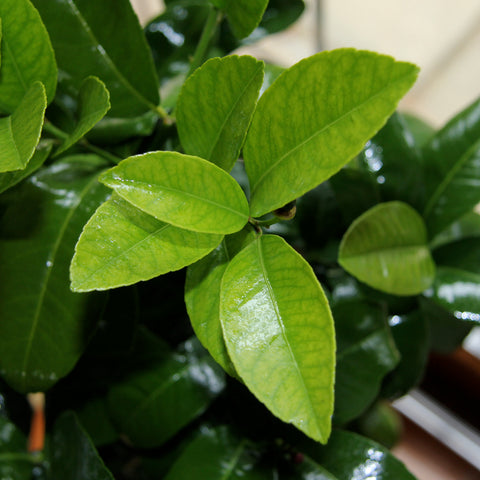With winter quickly approaching the cold, wet weather is finally upon us. Inevitably the temperatures inside our homes will be going up as we reach for the nearest dial to get the heating on.
For today’s blog, we will be going through some of the major do’s and don’ts for citrus tree winter care in the UK to keep your tree healthy and thriving all year round.
Citrus Tree Care in Winter

1. Reduce Watering
Citrus trees don’t tolerate wet soil at any point of the year but this is especially important during the winter months. As the weather is cooler and your tree isn’t growing as strongly you can reduce watering to every few weeks or only water when the top soil feels dry to the touch.
Citrus trees do not tolerate being left sitting in water; if left too long then the roots will begin to rot.
All you need to do is to watch for when the topsoil has completely dried out before watering again. Give your tree a good soak from the top, allow the excess water to drain away and place it back in it’s usual spot.
The water that comes straight from your taps can also be icy cold and give your tree a shock so we recommend keeping a water filled container at room temperature to prevent this. The best advice is really, just to follow these simple steps and you won’t go wrong when it comes to watering citrus plants.
2. Keep away from central heating!
Now, this is an important one! As the temperature drops outside, it’s inevitably that the temperatures inside your home will be going up as you grab for the nearest dial to whack the heat up.
If your lemon tree is currently being kept directly inside the house, then stop! Despite citrus trees being classed as 'indoor trees', they don’t like direct heat and central heating can dry out the air where humidity is needed. Citrus trees flourish in places with good air circulation and where they can receive plenty of light, so a porch area for example would be perfect.
3. Make sure it’s getting enough light
Citrus trees love their sunlight and as the sun is now setting earlier and rising later it’s important to get your tree in a bright location where it can still get a good few hours of direct light a day.
4. Change up your feed
Citrus trees need balanced nourishment in summer and winter so top up soil with the nutrients of our winter citrus feed every few waterings for an extra boost. It will help aid your tree in growing a strong crop of fruits and protects the foliage during colder months.
However, when the weather starts to get a little warmer, it important to switch over to our Summer citrus feed. This feed contains nitrogen based nutrients which is necessary for foliage growth, whereas the winter feed contains more potassium and phosphorus for a healthy crop of fruits.
5. Watch out for leaf drop
If your citrus tree is starting to feel stressed it will usually let you know by dropping its leaves. Don’t worry though, although it looks scary, your tree is fine and just trying to let you know that something in its environment isn’t right.
See our full citrus leaf drop guide here.

6. Enjoy your hard work!
While citrus trees don’t necessarily follow a fruiting season in the UK, winter is usually the time when they will start to flower and fruit.
When it comes to picking the ripe fruit, there are no hard and fast rules about the best time to do this. The best advice in this is to look at the colouring and then to decide for yourself when the fruit looks ripe. If your tree is fairly young, then a good tip to promote growth is to harvest your fruit as soon as it looks ripe. This should encourage growth in years to come.
Citrus Tree Hardiness

Non-hardy Citrus Trees
Calamondin, orange, kumquat, and grapefruit trees are the least cold hardy of all the citrus and should be kept indoors for most of the year.
Nearly hardy Citrus Trees
Lemon trees, chinottos, and Kaffir limes fall right in the middle of the group and can be placed outdoors in the summer but should be moved indoors for the rest of the year.
Hardy Citrus Trees
Mandarin oranges and satsuma trees are one of the most cold hardy citrus varieties as well as the beautiful limequat, but should still be brought in during the winter for protection.
I hope this quick tip guide has been useful for anyone who owns a Lemon, Lime or Orange Tree and for those who are perhaps thinking about getting one of our citrus trees for Christmas, but you’re not sure how to care for it. If you would like to know more, then join us on our Facebook page and ask a question on there, or follow us on Twitter for more hints and tips this season.
You can also find our year round citrus tree care guide on the blog as well as a breakdown of care for each citrus variety.


